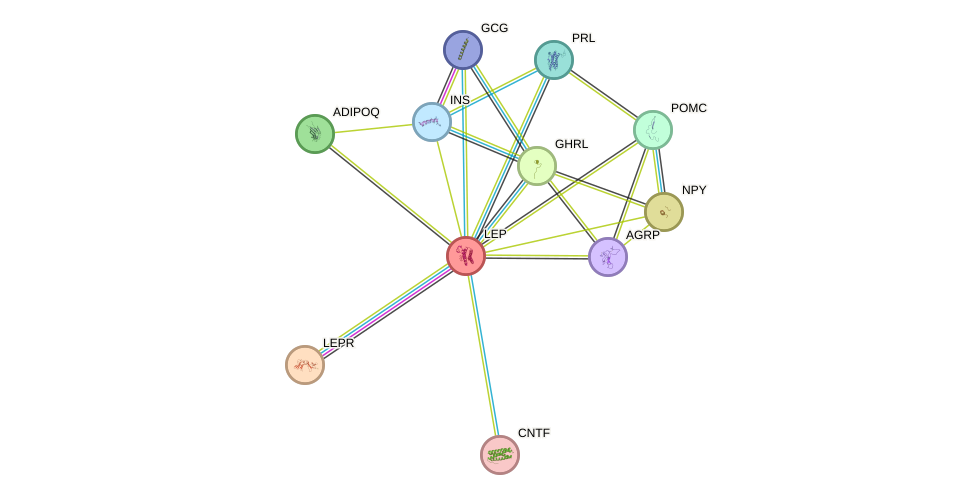GenAge entry for LEP (Homo sapiens)
Gene name (HAGRID: 217)
- HGNC symbol
- LEP
- Aliases
- OBS; OB
- Common name
- leptin
Potential relevance to the human ageing process
- Main reason for selection
- Entry selected based on indirect or inconclusive evidence linking the gene product to ageing in humans or in one or more model systems
- Description
LEP is secreted from adipose tissues and is involved in food intake and energy expenditure. Mice with mutations in the LEP gene are obese [1212]. Female mice injected with LEP grew slower but had an early onset of reproductive function [1565]. LEP deficiency in humans is associated with early-onset obesity [1741]. Due to its impact on energy metabolism and reproduction, LEP could be related to neuroendocrine systems involved in ageing as well as play a part in age-related diseases such as diabetes and atherosclerosis.
Cytogenetic information
- Cytogenetic band
- 7q31.3
- Location
- 128,241,278 bp to 128,257,629 bp
- Orientation
- Plus strand
Protein information
- Gene Ontology
-
Process: GO:0000122; negative regulation of transcription from RNA polymerase II promoter
GO:0001525; angiogenesis
GO:0001542; ovulation from ovarian follicle
GO:0001666; response to hypoxia
GO:0001890; placenta development
GO:0001936; regulation of endothelial cell proliferation
GO:0002021; response to dietary excess
GO:0003300; cardiac muscle hypertrophy
GO:0006006; glucose metabolic process
GO:0006111; regulation of gluconeogenesis
GO:0006112; energy reserve metabolic process
GO:0006114; glycerol biosynthetic process
GO:0006629; lipid metabolic process
GO:0006635; fatty acid beta-oxidation
GO:0006909; phagocytosis
GO:0007260; tyrosine phosphorylation of STAT protein
GO:0007565; female pregnancy
GO:0007623; circadian rhythm
GO:0008203; cholesterol metabolic process
GO:0008206; bile acid metabolic process
GO:0008217; regulation of blood pressure
GO:0008343; adult feeding behavior
GO:0010507; negative regulation of autophagy
GO:0010888; negative regulation of lipid storage
GO:0014068; positive regulation of phosphatidylinositol 3-kinase signaling
GO:0014823; response to activity
GO:0019953; sexual reproduction
GO:0021954; central nervous system neuron development
GO:0030073; insulin secretion
GO:0030217; T cell differentiation
GO:0030300; regulation of intestinal cholesterol absorption
GO:0032008; positive regulation of TOR signaling
GO:0032099; negative regulation of appetite
GO:0032310; prostaglandin secretion
GO:0032355; response to estradiol
GO:0032615; interleukin-12 production
GO:0032760; positive regulation of tumor necrosis factor production
GO:0032814; regulation of natural killer cell activation
GO:0032817; regulation of natural killer cell proliferation
GO:0032868; response to insulin
GO:0033197; response to vitamin E
GO:0033210; leptin-mediated signaling pathway
GO:0033686; positive regulation of luteinizing hormone secretion
GO:0035360; positive regulation of peroxisome proliferator activated receptor signaling pathway
GO:0035630; bone mineralization involved in bone maturation
GO:0038108; negative regulation of appetite by leptin-mediated signaling pathway
GO:0042102; positive regulation of T cell proliferation
GO:0042269; regulation of natural killer cell mediated cytotoxicity
GO:0042445; hormone metabolic process
GO:0042517; positive regulation of tyrosine phosphorylation of Stat3 protein
GO:0042593; glucose homeostasis
GO:0042755; eating behavior
GO:0043066; negative regulation of apoptotic process
GO:0043270; positive regulation of ion transport
GO:0043410; positive regulation of MAPK cascade
GO:0044320; cellular response to leptin stimulus
GO:0045471; response to ethanol
GO:0045639; positive regulation of myeloid cell differentiation
GO:0045765; regulation of angiogenesis
GO:0045906; negative regulation of vasoconstriction
GO:0046325; negative regulation of glucose import
GO:0046427; positive regulation of JAK-STAT cascade
GO:0046628; positive regulation of insulin receptor signaling pathway
GO:0046850; regulation of bone remodeling
GO:0046881; positive regulation of follicle-stimulating hormone secretion
GO:0048639; positive regulation of developmental growth
GO:0050796; regulation of insulin secretion
GO:0050810; regulation of steroid biosynthetic process
GO:0050892; intestinal absorption
GO:0050901; leukocyte tethering or rolling
GO:0050999; regulation of nitric-oxide synthase activity
GO:0051726; regulation of cell cycle
GO:0051897; positive regulation of protein kinase B signaling
GO:0060587; regulation of lipoprotein lipid oxidation
GO:0060612; adipose tissue development
GO:0061037; negative regulation of cartilage development
GO:0070093; negative regulation of glucagon secretion
GO:0071298; cellular response to L-ascorbic acid
GO:0071300; cellular response to retinoic acid
GO:0072604; interleukin-6 secretion
GO:0072606; interleukin-8 secretion
GO:0090335; regulation of brown fat cell differentiation
GO:0098868; bone growth
GO:1900015; regulation of cytokine production involved in inflammatory response
GO:1900745; positive regulation of p38MAPK cascade
GO:1904651; positive regulation of fat cell apoptotic process
GO:1990051; activation of protein kinase C activity
GO:2000366; positive regulation of STAT protein import into nucleus
GO:2000379; positive regulation of reactive oxygen species metabolic process
GO:2000486; negative regulation of glutamine transport
GO:2000491; positive regulation of hepatic stellate cell activation
Cellular component: GO:0005576; extracellular region
GO:0005615; extracellular space
GO:0005737; cytoplasm
Hide GO termsFunction: GO:0005179; hormone activity
GO:0008083; growth factor activity
GO:0051428; peptide hormone receptor binding
Protein interactions and network
Retrieve sequences for LEP
Homologs in model organisms
In other databases
- LongevityMap
- This gene is present as LEP

